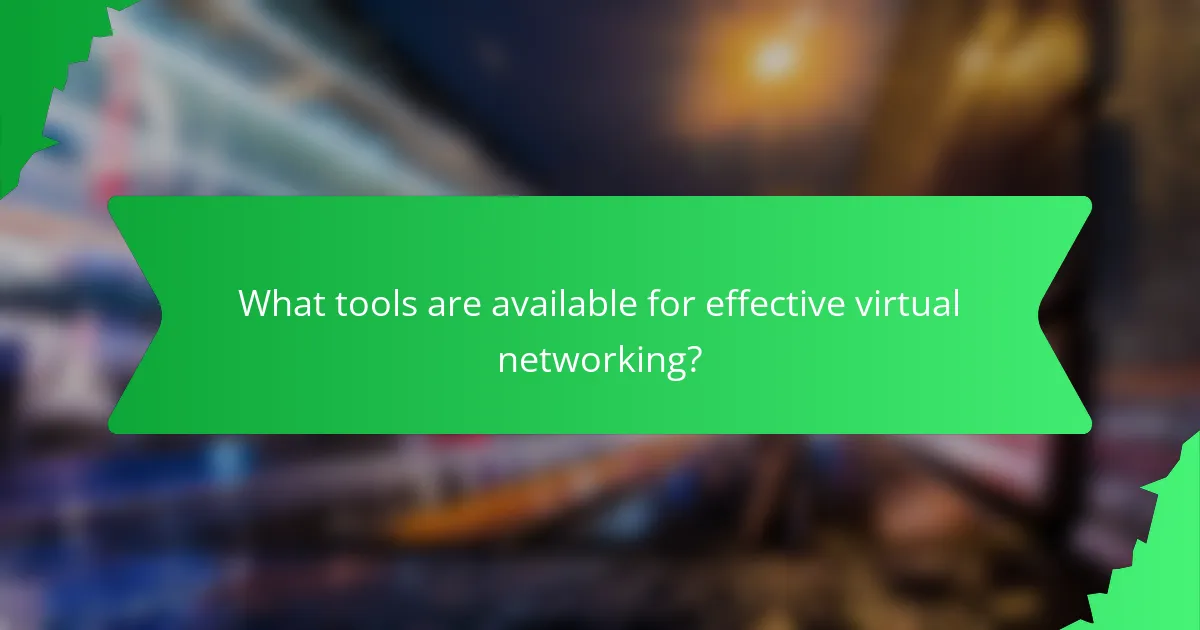Virtual networking is a critical factor influencing entrepreneurial success by providing access to a wider audience and fostering connections with potential partners, investors, and customers. Research shows that 70% of entrepreneurs view networking as essential for growth, with strong networks correlating to increased business opportunities. Key tools for effective virtual networking include Zoom, LinkedIn, and Slack, which facilitate communication and collaboration. The rise of hybrid events, artificial intelligence, and immersive technologies like virtual reality are shaping the future of networking, emphasizing community building and relationship development. Testimonials from entrepreneurs highlight the tangible benefits of virtual networking, including enhanced accessibility to industry leaders and successful partnerships.

What is the impact of virtual networking on entrepreneurial success?
Virtual networking significantly enhances entrepreneurial success. It provides access to a broader audience beyond geographical limitations. Entrepreneurs can connect with potential partners, investors, and customers more easily. This connectivity fosters collaboration and innovation in business strategies.
Research indicates that 70% of entrepreneurs believe networking is crucial for growth. A study by the Harvard Business Review found that strong networks lead to increased business opportunities. Furthermore, virtual networking platforms allow for cost-effective marketing and brand visibility.
Overall, the impact of virtual networking is profound, driving growth and opportunities for entrepreneurs.
How has virtual networking evolved in the entrepreneurial landscape?
Virtual networking has significantly evolved in the entrepreneurial landscape due to technological advancements and changing business needs. Initially, networking relied heavily on in-person events and face-to-face meetings. The COVID-19 pandemic accelerated the shift to online platforms. Entrepreneurs have increasingly utilized tools like Zoom, LinkedIn, and Slack for networking. These platforms facilitate global connections without geographical limitations. Research indicates that 70% of entrepreneurs have leveraged virtual networking to expand their reach. Additionally, virtual events often provide more accessible and diverse networking opportunities. As a result, virtual networking has become a staple in entrepreneurial strategies.
What are the key factors driving the rise of virtual networking?
The key factors driving the rise of virtual networking include technological advancements, increased globalization, and the need for flexibility. Technological advancements have made high-quality video conferencing and collaboration tools widely accessible. Increased globalization allows entrepreneurs to connect with a diverse range of professionals across geographical boundaries. The need for flexibility in work arrangements has made virtual networking more appealing. According to a 2021 report by Statista, 70% of professionals prefer virtual meetings for convenience. This shift has resulted in a significant increase in virtual networking events and platforms.
How does virtual networking differ from traditional networking?
Virtual networking primarily occurs online, while traditional networking takes place in person. Virtual networking leverages digital platforms for communication and relationship-building. This method allows for broader geographic reach, enabling connections across different regions. Traditional networking often relies on face-to-face interactions, which can create stronger personal bonds.
In virtual networking, events such as webinars and online conferences facilitate engagement. Traditional networking events typically involve physical gatherings like conferences and meetups. Virtual networking can be more time-efficient, allowing participants to connect without travel. In contrast, traditional networking often requires more time commitment due to travel and in-person attendance.
Statistics show that virtual networking has increased in popularity, especially during events like the COVID-19 pandemic. This shift highlights the adaptability of networking practices in response to global changes.
Why is virtual networking essential for entrepreneurs today?
Virtual networking is essential for entrepreneurs today due to its ability to expand reach and foster connections. It allows entrepreneurs to connect with a global audience without geographical limitations. This accessibility can lead to new partnerships, clients, and opportunities. According to a survey by LinkedIn, 70% of professionals reported that networking is crucial for career success. Additionally, virtual networking provides cost-effective solutions compared to traditional networking events. Entrepreneurs can save on travel and accommodation expenses while still gaining valuable insights and collaborations. The rise of digital platforms has made it easier than ever to share ideas and resources, enhancing innovation and growth.
What advantages does virtual networking provide for business growth?
Virtual networking offers significant advantages for business growth. It facilitates access to a global audience, allowing businesses to connect with potential clients and partners beyond geographical limitations. This wider reach can lead to increased opportunities for collaboration and sales.
Moreover, virtual networking reduces costs associated with traditional networking methods, such as travel and venue expenses. Companies can allocate these savings to other growth initiatives.
Additionally, virtual networking platforms often provide tools for tracking engagement and follow-ups. This data can be invaluable for refining marketing strategies and improving customer relations.
According to a report by LinkedIn, 85% of jobs are filled through networking, highlighting its importance in business development.
Overall, virtual networking enhances visibility, reduces expenses, and improves efficiency in building professional relationships.
How can virtual networking enhance collaboration among entrepreneurs?
Virtual networking enhances collaboration among entrepreneurs by providing accessible platforms for interaction. These platforms enable entrepreneurs to connect regardless of geographical barriers. Access to diverse perspectives fosters innovation and idea exchange. Entrepreneurs can share resources and knowledge efficiently through virtual meetings. This collaboration can lead to joint ventures and partnerships. Statistics show that 70% of entrepreneurs find networking crucial for business growth. Virtual networking tools like Zoom and Slack facilitate real-time communication. These tools also allow for the sharing of documents and project management, streamlining collaborative efforts.

What tools are available for effective virtual networking?
Effective virtual networking tools include Zoom, LinkedIn, and Slack. Zoom facilitates video conferencing and webinars, allowing real-time interaction. LinkedIn serves as a professional networking platform for connecting with industry peers. Slack provides channels for team communication and collaboration, enhancing networking within organizations. Other tools like Microsoft Teams and Discord also support virtual networking through chat and video features. These platforms enable users to share resources, engage in discussions, and build professional relationships. According to a study by LinkedIn, 85% of jobs are filled through networking, highlighting the importance of these tools in professional success.
Which platforms are most popular among entrepreneurs for virtual networking?
LinkedIn, Zoom, and Slack are the most popular platforms among entrepreneurs for virtual networking. LinkedIn offers a professional environment for connecting and sharing industry insights. Zoom enables face-to-face meetings, enhancing personal connections. Slack facilitates ongoing communication through channels and direct messaging. According to a 2023 survey by HubSpot, 70% of entrepreneurs use LinkedIn for networking. Additionally, 65% reported using Zoom for virtual meetings. These platforms provide valuable tools for building relationships and collaborating effectively.
What features should entrepreneurs look for in virtual networking tools?
Entrepreneurs should look for user-friendly interfaces in virtual networking tools. A simple interface enhances usability and encourages engagement. Real-time communication features are essential for instant interaction. This includes chat, video, and audio capabilities. Networking tools should also offer customizable profiles for users to showcase their expertise. Integration with social media platforms extends reach and visibility. Analytics features provide insights into user engagement and networking effectiveness. Security measures are crucial to protect sensitive information. Finally, mobile compatibility allows networking on the go, increasing accessibility.
How do different tools cater to various networking needs?
Different tools cater to various networking needs by offering specialized functionalities. For instance, video conferencing tools like Zoom facilitate real-time communication. These tools support virtual meetings, enhancing collaboration among remote teams. Social media platforms, such as LinkedIn, focus on professional networking. They allow users to connect, share experiences, and explore job opportunities. Project management tools, like Trello, help teams coordinate tasks and streamline workflows. These tools ensure that everyone is aligned on project goals. Additionally, messaging apps, such as Slack, provide instant communication for quick interactions. This fosters efficient team dynamics. Each tool addresses distinct aspects of networking, from communication to collaboration, making them essential for different networking scenarios.
How can entrepreneurs leverage social media for networking?
Entrepreneurs can leverage social media for networking by actively engaging with their target audience. They should create informative content that showcases their expertise. This builds credibility and attracts potential connections. Entrepreneurs can join industry-specific groups on platforms like LinkedIn and Facebook. These groups facilitate discussions and provide opportunities for collaboration. Networking events can also be promoted through social media channels. According to a 2021 survey by LinkedIn, 85% of professionals consider networking essential for career success. This statistic underscores the importance of social media in expanding professional networks.
What strategies can be used to build a professional presence online?
To build a professional presence online, individuals should utilize several effective strategies. First, creating a strong personal brand is essential. This involves defining unique skills and values. Next, maintaining active profiles on professional networking sites like LinkedIn is crucial. Regularly sharing relevant content enhances visibility and engagement.
Engaging with industry peers through comments and discussions fosters relationships. Additionally, joining online professional groups can expand networks. Consistently updating profiles with achievements showcases growth. Lastly, utilizing a personal website or portfolio can effectively display work and expertise. These strategies collectively contribute to a robust online professional presence.
How can entrepreneurs engage with their audience effectively on social media?
Entrepreneurs can engage with their audience effectively on social media by creating authentic content. Authentic content resonates with users and fosters trust. Regularly posting updates keeps the audience informed and engaged. Utilizing interactive features like polls and Q&A sessions encourages audience participation. Responding promptly to comments and messages shows that entrepreneurs value their audience’s input. Sharing user-generated content builds community and loyalty. Analyzing engagement metrics helps entrepreneurs understand what content works best. According to Sprout Social, 70% of consumers feel more connected to brands with a strong social media presence.

What trends are shaping the future of virtual networking?
Hybrid events are a significant trend shaping the future of virtual networking. These events combine in-person and virtual elements, allowing broader participation. According to a report by Eventbrite, 67% of event organizers plan to host hybrid events in the coming year. Increased use of artificial intelligence is another trend. AI enhances networking experiences by personalizing connections and automating tasks. A study by McKinsey found that AI can improve user engagement by 30%. Furthermore, the rise of immersive technologies like virtual reality is transforming networking. VR creates more engaging environments for interactions. Research from PwC shows that VR can increase retention rates by up to 75%. Lastly, the focus on community building is growing. Networking platforms are emphasizing relationship development over transactional interactions. This shift is supported by data indicating that strong networks lead to higher entrepreneurial success.
How are emerging technologies influencing virtual networking?
Emerging technologies are significantly influencing virtual networking by enhancing connectivity and collaboration. Innovations such as artificial intelligence, machine learning, and blockchain are streamlining communication processes. These technologies allow for personalized networking experiences through data analysis. AI-driven platforms can suggest relevant connections based on user behavior and preferences. Virtual reality (VR) is creating immersive networking environments that simulate face-to-face interactions. This enhances engagement and relationship-building among participants. Additionally, tools like video conferencing and instant messaging have made networking more accessible and efficient. A report by McKinsey states that companies utilizing these technologies have seen a 30% increase in networking effectiveness. Overall, emerging technologies are transforming virtual networking into a more dynamic and productive experience.
What role does artificial intelligence play in enhancing networking experiences?
Artificial intelligence enhances networking experiences by automating connections and personalizing interactions. AI algorithms analyze user data to suggest relevant contacts. This leads to more meaningful networking opportunities. Additionally, AI-powered chatbots facilitate real-time communication. They provide instant responses to inquiries, improving engagement. AI tools also help in managing events by optimizing schedules and attendee interactions. According to a report by PwC, 70% of businesses believe AI improves networking efficiency. These advancements demonstrate AI’s significant role in transforming networking landscapes.
How is the shift towards remote work impacting networking opportunities?
The shift towards remote work is significantly reducing traditional networking opportunities. In-person interactions are less frequent, limiting face-to-face connections. Virtual networking events have increased, but they often lack the personal touch of physical meetings. A study by Buffer in 2021 indicated that 98% of remote workers miss in-person interaction. Networking relies heavily on spontaneous conversations, which are harder to replicate online. Remote work can lead to isolation, reducing the chance to meet new contacts. However, online platforms like LinkedIn facilitate connections across geographical boundaries. This shift requires professionals to adapt their networking strategies to leverage digital tools effectively.
What are the challenges faced by entrepreneurs in virtual networking?
Entrepreneurs face several challenges in virtual networking. One major challenge is the lack of personal connection. Virtual interactions can feel impersonal compared to face-to-face meetings. This can hinder relationship-building efforts. Another challenge is technical difficulties. Issues like poor internet connection can disrupt communication. Additionally, entrepreneurs may struggle with time zone differences. Coordinating meetings across different time zones can be complicated.
Moreover, entrepreneurs often encounter information overload. The abundance of online resources can be overwhelming. This makes it difficult to identify valuable connections. Lastly, maintaining engagement can be challenging. Virtual platforms can lead to distractions, reducing focus during networking events. These challenges collectively impact the effectiveness of virtual networking for entrepreneurs.
How can entrepreneurs overcome barriers to effective virtual networking?
Entrepreneurs can overcome barriers to effective virtual networking by leveraging technology and establishing clear communication strategies. Utilizing platforms like Zoom or LinkedIn enhances connectivity. Setting specific goals for networking sessions fosters focus and purpose. Engaging in active listening during conversations builds rapport. Following up with personalized messages after meetings strengthens relationships. Joining industry-specific groups can provide targeted networking opportunities. Participating in webinars or online events expands visibility and reach. Research shows that 70% of entrepreneurs find networking crucial for business growth.
What common pitfalls should entrepreneurs avoid in virtual networking?
Entrepreneurs should avoid several common pitfalls in virtual networking. One major pitfall is failing to prepare adequately for virtual events. Preparation includes researching participants and creating a clear agenda. Another mistake is neglecting to follow up after meetings. Consistent follow-up can strengthen connections and foster relationships. Additionally, entrepreneurs often overlook the importance of engaging with their audience. Active participation and asking questions can enhance networking outcomes.
Many entrepreneurs also make the error of treating virtual networking as a transactional interaction. Building genuine relationships is crucial for long-term success. Lastly, technical issues can hinder effective communication. Ensuring reliable technology and a stable internet connection is essential for smooth interactions.

What testimonials illustrate the success of virtual networking?
Testimonials illustrating the success of virtual networking often highlight increased connectivity and opportunities. Entrepreneurs report forming valuable partnerships through online platforms. For example, a survey by LinkedIn found that 70% of professionals credit virtual networking for career advancements. Additionally, many users share success stories of landing clients via virtual networking events. These testimonials emphasize the effectiveness of webinars and online meetups in expanding professional circles. Participants frequently mention enhanced accessibility to industry leaders through virtual channels. Overall, these accounts demonstrate that virtual networking significantly contributes to entrepreneurial success.
How have entrepreneurs benefited from virtual networking experiences?
Entrepreneurs have benefited from virtual networking experiences by gaining access to a broader audience and new opportunities. These platforms allow entrepreneurs to connect with potential clients, investors, and partners globally. Virtual networking reduces geographical barriers, enabling relationships that may not have been possible otherwise.
Additionally, these experiences often provide cost-effective ways to engage with others. Entrepreneurs save on travel expenses and time while still achieving meaningful connections. Research indicates that 70% of entrepreneurs report increased collaboration opportunities through virtual networking.
Furthermore, virtual networking events frequently feature expert speakers and workshops. This access to knowledge and resources enhances entrepreneurs’ skills and business strategies. Overall, virtual networking has become a vital tool for entrepreneurial growth and success.
What specific success stories highlight the impact of virtual networking?
Many success stories illustrate the impact of virtual networking. One notable example is the rise of the online platform LinkedIn. LinkedIn has facilitated connections for millions of professionals, leading to significant career advancements. According to a survey by Jobvite, 70% of people were hired at companies where they had connections. Another success story involves the startup Zoom, which gained immense popularity during the COVID-19 pandemic. Its virtual networking capabilities allowed businesses to maintain operations and foster connections. Research from McKinsey shows that companies using digital tools for collaboration experienced a 20-25% increase in productivity. These examples highlight the transformative power of virtual networking in enhancing professional opportunities and business growth.
How do testimonials reflect the changing dynamics of networking?
Testimonials reflect the changing dynamics of networking by showcasing the importance of credibility and trust in virtual environments. In traditional networking, personal interactions established relationships. However, in virtual networking, testimonials serve as social proof that influences decision-making. They highlight individual experiences and successes, which resonate with potential connections. Research indicates that 79% of consumers trust online reviews as much as personal recommendations. This shift emphasizes the role of digital reputation in networking. Testimonials also demonstrate the effectiveness of online platforms in fostering professional relationships. As networking evolves, the reliance on testimonials continues to grow, shaping how entrepreneurs connect and collaborate.
What best practices can entrepreneurs adopt for successful virtual networking?
Entrepreneurs can adopt several best practices for successful virtual networking. First, they should create a professional online presence. This includes having a well-designed website and active social media profiles. Next, entrepreneurs must engage in relevant online communities. Participating in forums and groups related to their industry fosters connections. Additionally, they should utilize video conferencing tools effectively. High-quality video calls can enhance communication and relationship-building.
Another best practice is to follow up after networking events. Sending personalized messages reinforces connections made during interactions. Entrepreneurs should also be prepared with a clear elevator pitch. This helps convey their value proposition succinctly. Finally, they should maintain consistency in networking efforts. Regular engagement helps build trust and visibility over time. These strategies contribute to establishing strong professional relationships in the virtual space.
How can entrepreneurs create meaningful connections in a virtual environment?
Entrepreneurs can create meaningful connections in a virtual environment by leveraging digital platforms for engagement. Utilizing video conferencing tools fosters face-to-face interaction, enhancing personal connections. Participating in online forums and communities allows entrepreneurs to share insights and experiences. Networking events, hosted virtually, provide opportunities to meet industry peers. Regular follow-ups via email or social media strengthen these connections over time. Personalizing communication by addressing individuals by name increases relatability. Sharing valuable content, such as industry trends or personal stories, adds value to interactions. Research shows that 70% of professionals value personal connections in networking, reinforcing the importance of genuine engagement.
What tips can enhance the effectiveness of virtual networking efforts?
To enhance the effectiveness of virtual networking efforts, focus on clear communication and active engagement. Utilize video calls to create a personal connection. Prepare an elevator pitch to succinctly convey your message. Follow up promptly after meetings to reinforce connections. Join relevant online communities to expand your network. Share valuable content to establish your expertise. Attend webinars and virtual events to meet like-minded professionals. Research your contacts before reaching out to personalize your approach.
The primary entity of the article is virtual networking, which plays a crucial role in enhancing entrepreneurial success. The article outlines the significant impact of virtual networking on business growth, emphasizing its ability to connect entrepreneurs with a global audience and foster collaboration. Key trends driving the rise of virtual networking, such as technological advancements and the shift towards remote work, are discussed alongside popular tools like Zoom, LinkedIn, and Slack. Additionally, the article highlights challenges faced by entrepreneurs in virtual networking and offers best practices for creating meaningful connections, supported by testimonials that illustrate the effectiveness of these strategies.
